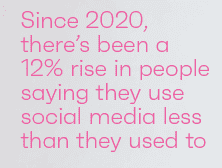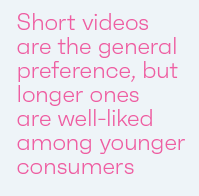Regular readers of this blog will know that we are great fans of GWI’s reports.
All figures in this latest 38 page report on global social edia trends in 2022 are drawn from GWI’s online research among internet users aged 16-64. Their figures are representative of the online populations of each market, not its total population. Note that in many markets in Latin America, the Middle-East and Africa, and the Asia-Pacific region, low internet penetration rates can mean that online populations are more young, urban, affluent, and educated than the total population. Each year, GWI interviews over 700,000 internet users aged 16-64 via an online questionnaire for their Core dataset. A proportion of respondents complete a shorter version of this survey via mobile; hence the sample sizes presented in the charts may differ as some will include all respondents, and others will include only respondents who completed GWI’s Core survey via PC/laptop/tablet.
Below is a very topline summary of some of the key findings, with a link to the full report at the bottom.
Key Insights
Social media engagement has plateaued globally – Q2 2020 boasts the highest figures on record for global social media usage as widespread lockdowns forced consumers to find ways to fill their free time. Engagement has fluctuated a little since, but ultimately leveled off. MEA bucks this overall trend, with its consumers still making leaps in usage.Since Q2 2021, time spent on social media has increased in 32 of the 47 countries tracked, with consumers in MEA upping their usage by around 20 minutes in the space of a few months. This sounds promising, but after taking a step back, we can see that global engagement has generally slowed down. Time spent on social media has been a bit of a rollercoaster over the last 5 years. Between 2014-2018, the average time spent on networks was making steady strides forward, increasing by almost 40 minutes. The numbers then started to plateau in 2019, only to be interrupted by the pandemic. Q2 2020, when around half the world’s population was under some form of lockdown, still boasts the highest figures on record for global usage. Back then, the long-term impact of this uptick wasn’t clear; but it is now. Engagement has fluctuated a little, but ultimately leveled off. If we take MEA out of the equation, the global average is what it was three years ago.
- TikTok continues its impressive growth – Since 2020, the number of consumers using TikTok monthly has grown by 32%. Despite its youthful reputation, engagement has grown the most among Gen X and baby boomers. Its popularity doesn’t show any signs of slowing and older consumers have a hand in this trend. Despite growing competition, Facebook isn’t going anywhere. It tops our global leadership board and most younger consumers use it each month. Especially with so many websites using Facebook Login to speed up the sign-in process, it’s well-embedded in people’s
online experience. That being said, Gen Z has a special place for Instagram. In every quarter since Q2 2019, more 16-24s have visited Instagram than Facebook. A quick glance back at their social media motivations helps explain this: for all other generations, finding news is one of their top three reasons for using social networks; whereas Gen Z places more priority on finding content and seeing what’s trending. WhatsApp and Facebook Messenger are the most popular global messaging services. While Facebook Messenger leads in North America, WhatsApp comes out on marketing channels, but there’s a clear and growing business case for experimenting with these apps. Engagement with WhatsApp has almost reached a saturation point among consumers in Latin America, with its figures even surpassing WeChat’s penetration in China. But few people only use one messaging service and new players with unique selling points are making a name for themselves.
- Western social media is following in China’s footsteps – Social media typically fulfils a wider brief in fast-growth markets like China than in the West. However, our data suggests change is coming. Compared to 2020, people in North America are more likely to log onto platforms with commercial activities in mind. Social media typically fulfils a wider brief in fast-growth markets like China than in the West. For example, consumers in Asia Pacific over-index most for using platforms to watch livestreams, and those in Latin America for finding things to buy; whereas in North America, the most distinctive reason for logging on is keeping in touch with friends and family. However, our data suggests change is coming. We’ve also seen increases among work decision-makers in the West using sites like YouTube, Instagram, and Facebook for product research. It’s going to take time, but efforts to integrate content and commerce in the West haven’t been in vain. WhatsApp’s shift toward in-app ecommerce is a The main differences between markets nod in the right direction. Having introduced catalogs and shopping carts last year, the app lets users complete online purchases with one text message. Likewise, TikTok plans to follow in Douyin’s footsteps by introducing online food delivery in America. New solutions that blur the line between payment services and social media have also gained influence, with Cash App growing its U.S. engagement figures by 24% since Q1 2021. As attitudes soften, and as messaging and mobile payment services continue to mesh, the pace of social commerce is set to pick up in the West.
Short-form video is most popular, but long-form lands well with Gen Z – Outside China, 61% of social media users say they view or create a story on Snapchat, Instagram, or Facebook at least monthly, and there’s been a rise in engagement with Reels. It’s not all about bitesize content though – Gen Z are just as likely to be watching 20+ minute videos as they are <4 minute ones. Across every age group and country in our Zeitgeist study, short-form content is more popular than long-form. TikTok may have kickstarted a new era of bite-sized videos, but many social platforms now offer their own alternative. Reels have been around for some time, but they’re picking up steam. In fact, there’s been a 20% increase in the number of Instagram users engaging with this feature since 2020. Companies need to meet consumers where they are to make the most impact, which means upping their investments in this format is likely to pay off. While short-form content is the preference, long videos have their place. Short clips are typically associated with Gen Z, but the gap between the two types is greatest in Western markets and among baby boomers. This is explained by younger consumers’ appetite for how-to videos and vlogs.
- Social buying has made a lot of headway and is set to spread – Despite security worries, engagement with Facebook Marketplace and Instagram Shopping has gone up by 8% since 2020. Brands can drive progress by inspiring UGC – which will raise awareness – and help prevent cart abandonment by taking feedback on board. Overall, search engines (32%), ads seen on TV (31%), and word-of-mouth rec-ommendations (28%) top our brand discovery chart. But social media comes in all shapes and sizes, with sources like Q&A sites also falling under its umbrella. ROI agency Zenith pre-dicts that 2022 is the year that’ll see social media’s ad market overtake TV, which seems reasonable given how big this channel’s combined impact is. Even if we look at the habit of research-ing products on social networks alone, we can see they’re slowly gaining on search engines. The space between the two, which was 7 percentage points in 2020, now rests at 4. Plus, Gen Z passed an important milestone in Q3 2020; social networks are now the most common way they find out about brands or products. For them, the gap has already been filled and then some. Traditional formats are still important and this is unlikely to change anytime soon, but social net-works are taking up more room at the discovery table. Social shopping has taken flight, but it’s landing differently around the world. Latin Americans lead when it comes to engaging with promoted content and making in-app purchases. At the other end of the spectrum, Europeans are the most likely to use ad-blockers, the least confident about handling their data online, and the most reluctant to checkout in social spaces.




